-
Products
-
Accessories
- Back rests
- Big bore kits - Athena
- Bike & seat covers
- Caps & lids
- CrampBuster throttle control
- Crash protection
- Footguards
- Hand guards, extensions & mittens
- Lights
- Mud guards / chain guards
- Pet carriers
- Phone and navigation, smart mounts
- Power connection kits
- Radiator protection
- Safety accessories
- Scottoiler
- Security and padlocks
- Side stand supports
- Storage containers
- Sump Protection
- Batteries, chargers and accessories
-
Clothing
- Body armour, protectors and safety
- Boots
- Gloves
- Jackets - heritage & waxed
- Jackets - leather
- Jackets - textile
- Jackets - urban
- Rainwear / thermal wear
- Trousers - heritage & waxed
- Trousers - jeans and denim
- Trousers - leather
- Trousers - textile
- Women's clothing
-
Clearance / end of line / samples
- Samples / one-offs
- Boots clearance
- Gloves clearance
- Jackets - leather clearance - mens
- Jackets - leather clearance - ladies
- Jackets - textile clearance - mens
- Jackets - textile clearance - ladies
- Jeans and denim clearance
- Trousers - leather clearance - mens
- Trousers - leather clearance - ladies
- Trousers - textile clearance - mens
- Trousers - textile clearance - ladies
- Communications
- Engine Management (GET ECUs)
- Helmets
- Luggage
- Mufflers
-
Spare Parts
- Bar end weights and plugs
- Brake systems
- Carburettors and fueling
- Chain - Regina
- Clutch Systems
- Electrical
- Filters
- Forks
- Gaskets and seals
- Hand / foot controls
- Hose, clamps and clips
- Mirrors
- Piston kits - Athena
- Regulator rectifiers
- Screws, bolts, nuts, washers
- Shims for Ducati
- Shocks
- Side Stands
- Springs
- Sprockets
- Steering head bearings
- Tail tidy
- Wheel bearing and seal kits
- Clearance - spare parts
- Sprays, fluids and lubricants
- Stands, benches & wheel clamps
-
Tools
- Bearing tools
- Bike-specific tools
- Brake servicing
- Brushes
- Carburettor gauges & tools
- Chain tools
- Clutch hub tools
- Flywheel pullers
- Hook wrenches
- Oil filter removal tools
- Piston tools
- Plug spanners / T-bar sockets
- Spanners
- Specialty tools
- Spoke keys & wrenches
- Spring hooks
- Suspension tools
- Timing tools
- Tool trays
- Tyre repair
- Valve tools
- Wiring and electrical tools
- Tyre changing equipment
- Windscreens
-
Accessories
- Brands
- Specials
TECH TIPS: Brake pads - how to choose the right one
Posted in Technical tips
Many people are confused about how to choose the right brake pad for their motorcycle, be it road, scooter, off-road or racing.
Brembo recently published an excellent article, detailing the different brake pad compounds available and how to choose the right one for your bike. It’s a great read if you’re into reading long articles about brake pads, but maybe a bit too much for the average rider. We’ve summarised it here for your convenience, but please feel free to check out the full article here https://www.brembo.com/en/company/news/brembo-guide-to-the-right-pad if you feel so inclined.
FIRST, THE FUNDAMENTALS
Brakes are an essential part of any motorcycle or scooter and brake pads play a large part in the performance of the braking system. Not only a safety device, using the right brake pads for your application will improve the feel and performance of your bike and potentially save you money in the long run.
The compounds normally used in braking systems are classified into just two families - ORGANIC and SINTERED.
Sintered pads are made up of metallic powders forced together under heat and pressure in an adhesive-free process: the friction coefficient depends on the metallic powders used. Lubricants added to the initial compound ensure consistent and jerk-free braking while abrasives keep the discs clean, removing deposits from the braking band.
Organic pads include any pad that is not sintered, which explains why both carbon-ceramic and carbon-tech pads are in this class. The bonding resins are the main element, but organic pads also contain lubricants and abrasives in order to ensure the same benefits offered by sintered pads.
Each compound has its own specific properties and field of application to suit the different situations a brake pad may encounter. Brembo has an answer for every need. As well as the pads manufactured by Brembo for Original Equipment applications, Brembo offers a range of after-market compound options to give you the freedom of choice, depending on how you use your bike.
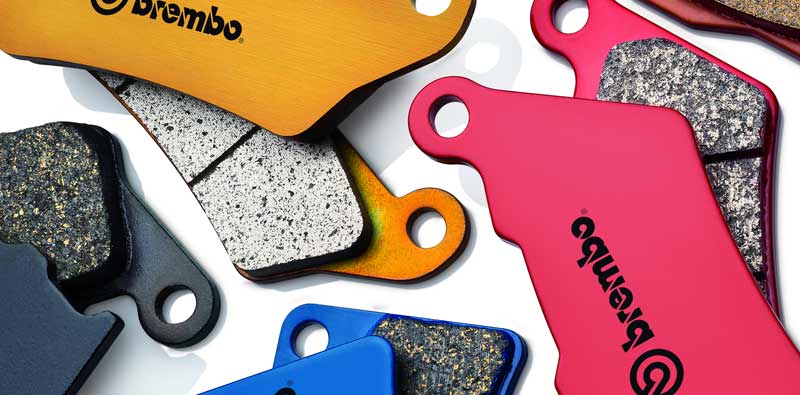
THE ROAD
For those who ride motorcycles on the road, there are four pad variations – three are sintered and one organic.
The one organic compound, CC is used by owners of more "docile" bikes, generally with an engine displacement smaller than 400 cc. CC is perfect for those who want softer, modular braking.
Of the sintered pads, the only one specifically for the rear is SP. One of its benefits is its consistent performance both cold and hot. For the front, on the other hand, you can choose between SA and LA. For anyone who considers performance to be their goal, the SA pad is a must and also performs well for the occasional track day.
On the other hand, if you are a rider who places touring use ahead of pure performance, devouring tens of thousands of miles every year, the ideal choice is the LA pad. Good performance and stability characteristics come with an exceptionally long life.
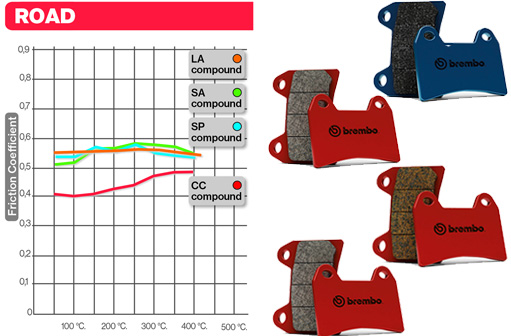
The dangers of the wrong choice
What would happen if we were to mount an SA pad on a small engine bike, used only on the road? Having been designed to ensure top performance, two problems would arise: it could struggle to reach optimum operating temperature, generating spongy braking, or it could provide an overly abrupt response. In both cases, pad wear would be abnormal.
Conversely, using a CC pad on a supersport bike would result in difficulty braking, especially from high speed. This compound is not suited to sustain all the braking power these road rockets need. You would find yourself with an expensive bike that has excellent acceleration, but is deficient in braking.
_____________________________________________________
OFF-ROAD
Because of the limited traction, dirt bikes do not need great braking power. The three available compounds are designed to provide good response without excessive braking action and can be used both on the front and on the rear.
For those who race motocross or motard, the ideal solution is the SX. A sintered pad designed for racing with high aggressiveness and resistance to high temperatures.
On the other hand, for those who ride enduro or simply want a sintered pad that provides good performance and excellent modular characteristics, they'll need to opt for the SD.
These two sintered pads are joined by an organic pad recommended for those who place high mileage ahead of absolute performance. The TT is made of semi-metallic carbon-ceramic and works just as well in the dry as it does in unpleasant atmospheric conditions.
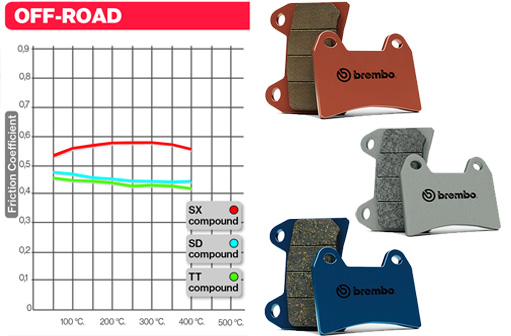
The dangers of the wrong choice
What would happen if we were to use an SX pad on an enduro bike at max cargo capacity (in other words, with all the bags loaded up and a passenger on the back)? Having been designed for more light and agile vehicles, it would struggle to slow down such a beast. Furthermore, when touring the long gaps between braking generates a drop in temperature which has an impact on braking efficiency.
Conversely, installing a TT pad on a bike that is stripped to the bone, like those used in motocross and motard championships, would result in a mild braking response. At every braking section, the competition would have an advantage of a few yards because the TT lacks the braking power of the SX. Of course, the pad would need to be replaced less frequently, but in the race, winning is what counts, not saving.
_____________________________________________________
RACING
The main characteristics required for this type of use are high friction and consistent performance, especially with high disc temperatures. These characteristics guarantee excellent and uniform braking for the entire duration of the race, making it less likely the fading phenomenon will occur. This is why efficiency at low temperatures takes on less importance and, consequently, they are not recommended for street use.
The performance version of this group is the organic RC pad, in carbon tech. The exceptional friction coefficient when hot guarantees powerful and stable braking, without the occurrence of the fading phenomenon (increased lever travel). This compound is available for all supersport bikes and the most aggressive naked sport bikes.
Similar to the RC but one step below is the SC. Like its sibling, this pad is also manufactured exclusively for the front, because great power at the rear brake is not necessary. The SC is stable in all conditions of use, but it is recommended for “light” track use and “sporty” street use. Brembo has also recently introduced an SRcompound, a new material that will begin replacing the old SC pads, which may see an even better sport pad available for bikes in future.
The pads with Brembo Racing Z04 compound on the other hand, are worthy of an entirely different conversation, a level above everything else.
This range of high performance Brembo pads was developed exclusively for racing and designed to provide maximum performance in the most extreme competitions: more braking control, stability of the system, increased braking power, resistance to high temperatures and reduced wear.
Brembo Racing Z04 pads are a true “Factory Pad”, available for the most common supersport bikes, but not recommended even for occasional street use.
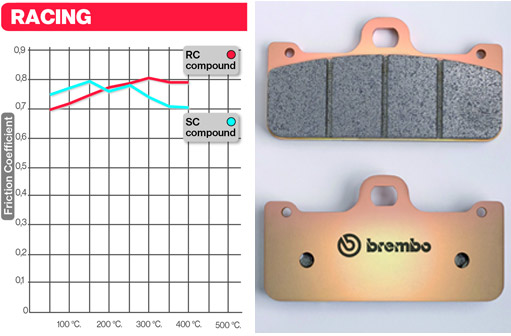
The dangers of the wrong choice
What would happen if we were to mount a CC pad on a supersport bike and use it on the track? From the very first braking section, all the other bikes on the track would fly past you. As if that weren't enough, with each passing lap, the system would overheat excessively, resulting in longer and longer braking distances until the system would fail entirely.
In the opposite case, if you were to use an RC pad on the road, fitted to a bike with limited weight and power, the result would be just as disappointing. The braking response would be decidedly too abrupt, with the risk of flipping over at any time, and the on-off effect generated would take all the fun out of the ride. In addition to the disappearance of the modular characteristic, they would also wear out extremely quickly.
_____________________________________________________
Scooters
Brembo pads for scooters (2 and 3-wheelers) guarantee long life and operating stability. They have been designed specifically for city use and the typical braking that comes with this type of vehicle, which is different to a full size motorcycle.
The Brembo compounds available for scooters are XS and CC.
XS is sintered and designed specifically for maxi-scooters, or higher performance scooters. The benefits are high power, modular characteristics and high mileage.
CC, on the other hand, uses organic material suitable for all scooters, including small fifty cc scooters: it is preferred by those who do not need great braking power, but want good performance and, above all, want to ensure low wear.
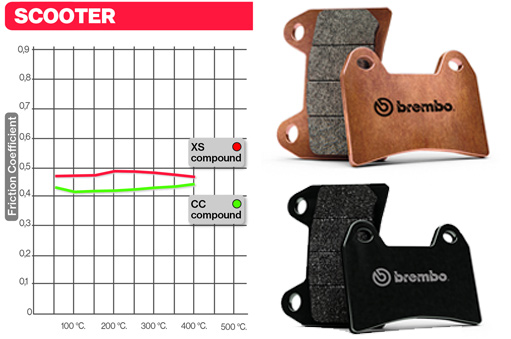
The dangers of the wrong choice
What would happen if we were to use an XS pad on a small scooter? Having been designed for much heavier and faster vehicles, it would provide an overly abrupt response and would lose all of its modular characteristics. Wear would also increase disproportionately, forcing the owner to replace the pad after only a short time.
Conversely, using a CC pad on a scooter with a large engine would result in a significant increase in braking distances. This pad was neither designed nor tested to sustain the braking power that medium-large scooters need.
Final word
To find out which pad options are available for your bike, go to the Brembo configurator (www.moto.brembo.com) and enter the necessary information about your motorcycle (click the slider icon at the top right of the page).
The configurator will quickly indicate which Brembo pads are available for your bike, including compound options. Once you’ve decided what you want, check to see if we have them in stock – simply copy the Brembo part number into our Eurobike search bar.
Brake pads can be ordered from your favourite bike shop. If you don’t find what you are looking for, send us an enquiry and we’ll do our best to help.
And remember, before you throw a leg over your bike with newly mounted Brembo pads, don't forget to break them in!
Keen to learn more? This article is Part 3 in our Braking Tech Tips series. Click here for Part 1 and click here for Part 2.

